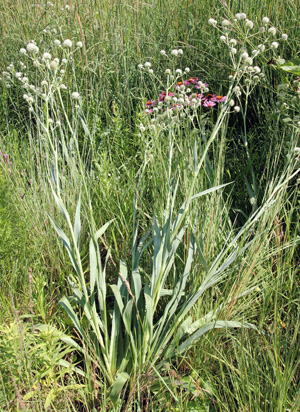
Rattlesnake master is an herbaceous perennial native to mesic tallgrass prairies, savannas and open rocky woods of the central and eastern United States. It is grown as an ornamental for its unique “golf ball” flowers. Although it occurs naturally primarily only in southern Wisconsin, it is often cultivated further north as it is hardy in zones 3-8. There are two varieties of this plant in the carrot family (Apiaceae): the more common Eryngium yuccifolium var. yuccifolium that this article refers to and southern rattlesnake master, Eryngium yuccifolium var. synchaetum, from wet pine savannas on the coastal plain from southeast North Carolina south into Florida, with much narrower leaves and growing in moister conditions. The common name “rattlesnake master” refers to the erroneous misconception that Native Americans used the root as an antidote for rattlesnake venom – although it was used medicinally. Other less frequently used common names include button snake-root, button eryngo, and beargrass.
The medium green, bluish, or gray-green foliage is almost entirely basal (a rosette) with just a few rudimentary leaves on the flower spikes. The narrow, sword-shaped leaves grow up to 3 feet long, forming a dense clump 2 to 3 feet wide. Each stiff leaf has parallel veins, bristly or spiny margins, and a pointed tip, reminiscent of a yucca leaf – hence the specific epithet. The foliage dies back after the plant blooms, with a number of offsets developing.
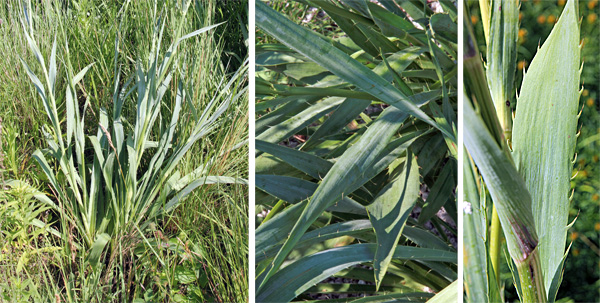
Unlike most members of the carrot family, the genus Eryngium does not have open, airy dome-shaped umbels but instead produces dense flowerheads with a thistle-like appearance.
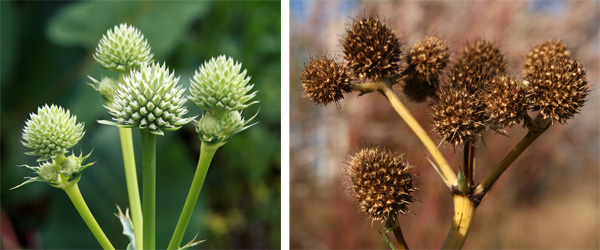
Plants bloom from mid to late summer with clusters of up to 10 white, green or bluish spherical heads. The terminal, branched clusters (cymes) are produced at the ends of robust, erect, smooth stems growing 3-4 feet tall (or sometimes more) from the center of the rosette. The greenish-white to purplish flowers are clustered in a central cone surrounded by spiny, pointed bracts; each prickly ball is up to an inch across. An individual flower has 5 white petals, a pistil divided into 2 white styles and 5 white stamens with light brown anthers.
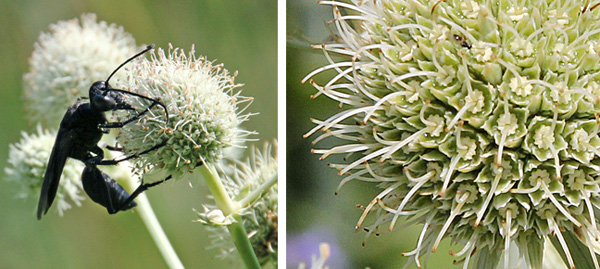
The pollen is shed before the stigmas become receptive, greatly reducing self-pollination and promoting outcrossing. The flowers are faintly fragrant, with a honey-like scent and attract a variety of pollinators including bees, wasps, flies, and butterflies. The flowerheads eventually turn a dull brown, full of small, ¼” long brown seeds (mericarps; 2 per fruit). The inflorescences can be used as an unusual cut or dried flower.
Use rattlesnake master in native gardens and prairies, individually or massed where the plants can provide support for each other. This plant works well as an accent in the perennial border, with the spiky leaves providing contrast in form and texture with many other garden ornamentals and the flowers adding architectural interest. It is a striking plant as a specimen rising above shorter plants, or in small groups and is right at home in a gravel garden. The plants provide interest in the winter landscape if not cut back at the end of the season.
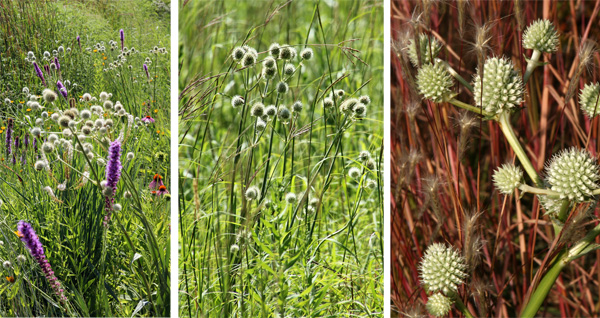
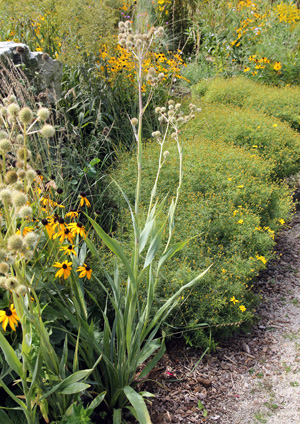
Rattlesnake master is easily grown in full sun in most garden soils, preferring sandy soils, but tolerating clay or rocky soils. It is drought tolerant, doing best in dry, lean soils. It will get floppy if grown in very fertile conditions or shade and may need staking to remain upright in gardens. Choose the site carefully when placing this plant; because it has a deep taproot it does not transplant well so is best left undisturbed once established. It has no significant insect or disease problems and is not favored by deer or rabbits.
This plant is easily propagated from seed and it will readily self-sow. Collected seeds germinate best if stratified for a month or sow outdoors in fall to germinate in the spring. Established plants can be divided in spring or fall, but because of the taproot this is often not the best method.
– Susan Mahr, University of Wisconsin – Madison
Ask Your Gardening Question
If you’re unable to find the information you need, please submit your gardening question here:





 Aster, Symphyotrichum spp.
Aster, Symphyotrichum spp. Fascinating Fasciation
Fascinating Fasciation Alternatives to Lawn: Groundcovers
Alternatives to Lawn: Groundcovers Marigolds
Marigolds


